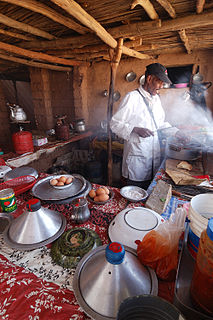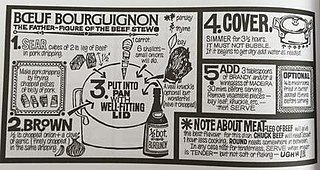 W
WCooking, cookery, or culinary arts is the art, science, and craft of using heat to prepare food for consumption. Cooking techniques and ingredients vary widely, from grilling food over an open fire to using electric stoves, to baking in various types of ovens, reflecting local conditions.
 W
WThe following outline is provided as an overview of and topical guide to food preparation:
 W
WIn cooking, al dente describes pasta or rice that is cooked to be firm to the bite. The etymology is Italian "to the tooth".
 W
WAl forno [al ˈforno] is food that has been baked in an oven. Italian dishes commonly prepared in this way include pizza, breads and pasta dishes, notably lasagna.
 W
WThe batterie de cuisine is the range of tools and pans used in a professional kitchen. It includes the knives, frying pans, bakeware and the complete set of kitchen utensils required for cooking and for the making of desserts, pastries and confectionery. It does not include any of the fixed equipment such as cooking ranges, refrigeration equipment, etc.
 W
WA cookbook or cookery book is a kitchen reference containing recipes.
 W
WCharcuterie is a French term for a branch of cooking devoted to prepared meat products, such as bacon, ham, sausage, terrines, galantines, ballotines, pâtés, and confit, primarily from pork.
 W
WThe traditional chef's uniform includes a toque blanche, white double-breasted jacket, pants in a black-and-white houndstooth pattern, and apron. It is a common occupational uniform in the Western world. The chef buttons also have a meaning; while qualified chefs wear black buttons, students wear white buttons. Kitchen brigades used to be massive, although today, chefs must be occupied in various areas of the kitchen, thus, being in charge for only one section is hardly possible anymore.
 W
WChimney cranes, also known as fireplace cranes and pot cranes, are a feature of the homes of the American Colonial period and 18/19th century of Western Europe. Although the chimney crane may be thought by some to be a Yankee invention, it was common in both British and American houses of the era. The purpose of the crane is to allow a cooking pot to be swung away from the fire, preventing burn injuries to the cook as well as regulating temperature of the pot. The chimney crane is an important step in open hearth cooking as it helped save lives and allowed cooks to be more creative.
 W
WChocolate is a food product made from roasted and ground cacao pods, that is available as a liquid, solid or paste, on its own or as a flavoring agent in other foods. Cacao has been consumed in some form since at least the Olmec civilization, and the majority of Mesoamerican people - including the Maya and Aztecs - made chocolate beverages.
 W
WIn recipes, quantities of ingredients may be specified by mass, by volume, or by count.
 W
WCookstrips are recipes drawn as black and white graphics with short instructions. They were invented by Len Deighton while studying at the Royal College of Art in the 1950s. Deighton, who is a keen cook, originally drew the cookstrips as instructions to himself in order to keep his expensive cookbooks from becoming dirty in his kitchen. "I’m very messy, and didn’t want to take them into the kitchen. So I wrote out the recipes on paper, and it was easier for me to draw three eggs than write ‘three eggs’. So I drew three eggs, then put in an arrow. For me it was a natural way to work."
 W
WA cuisine is a style of cooking characterized by distinctive ingredients, techniques and dishes, and usually associated with a specific culture or geographic region. Regional food preparation traditions, customs and ingredients often combine to create dishes unique to a particular region.
 W
WCulinary arts, in which culinary means "related to cooking", are the cuisine arts of food preparation, cooking, and presentation of food, usually in the form of meals. People working in this field – especially in establishments such as restaurants – are commonly called "chefs" or "cooks", although, at its most general, the terms "culinary artist" and "culinarian" are also used. Table manners are sometimes referred to as a culinary art.
 W
WOne aspect of energy poverty is lack of access to clean, modern fuels and technologies for cooking. As of 2020, more than 2.6 billion people in developing countries routinely cook with fuels such as wood, animal dung, coal, or kerosene. Burning these types of fuels in open fires or traditional stoves causes harmful household air pollution, resulting in an estimated 3.8 million deaths annually according to the World Health Organization (WHO), and contributes to various health, socio-economic, and environmental problems.
 W
WA garde manger is a cool, well-ventilated area where cold dishes are prepared and other foods are stored under refrigeration. The person in charge of this area is known as the chef garde manger or pantry chef. Larger hotels and restaurants may have garde manger staff to perform additional duties, such as creating decorative elements of buffet presentation like ice carving and edible centerpieces.
 W
WMise en place is a French culinary phrase which means "putting in place" or "everything in its place". It refers to the setup required before cooking, and is often used in professional kitchens to refer to organizing and arranging the ingredients that a cook will require for the menu items that are expected to be prepared during a shift.
 W
WThe Oxford Symposium on Food & Cookery is an annual weekend conference at which academics, food writers, cooks, and others with an interest in food and culture meet to discuss current issues in food studies and food history.
 W
WPellet grills, sometimes referred to as pellet smokers, are outdoor cookers that combine elements of charcoal smokers, gas grills, and kitchen ovens. Fueled by wood pellets, they can smoke as well as grill, braise, sear and bake using an PID electric control panel to automatically feed fuel pellets to the fire, regulate the grill’s airflow, and maintain consistent cooking temperatures.
 W
WA recipe is a set of instructions that describes how to prepare or make something, especially a dish of prepared food.
 W
WShort order cooking, in the restaurant business, is the preparation of foods that are quick to cook. Many small restaurants serve only short-order items, which include fried, broiled, griddled foods, as well as assembled foods like sandwiches.
 W
WDoneness is a gauge of how thoroughly cooked a cut of meat is based on its color, juiciness, and internal temperature. The gradations are most often used in reference to beef but are also applicable to other types of meat.
 W
WA toque is a type of hat with a narrow brim or no brim at all.
 W
WWine is an alcoholic drink typically made from fermented grapes. Yeast consumes the sugar in the grapes and converts it to ethanol and carbon dioxide, releasing heat in the process. Different varieties of grapes and strains of yeasts are major factors in different styles of wine. These differences result from the complex interactions between the biochemical development of the grape, the reactions involved in fermentation, the grape's growing environment (terroir), and the wine production process. Many countries enact legal appellations intended to define styles and qualities of wine. These typically restrict the geographical origin and permitted varieties of grapes, as well as other aspects of wine production. Wines not made from grapes involve fermentation of additional crops, including rice wine and other fruit wines such as plum, cherry, pomegranate, currant and elderberry.